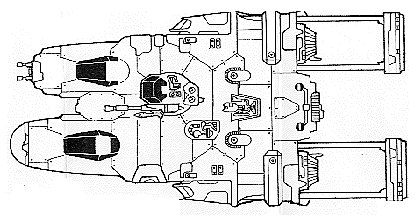
Ship Specs
Imperial Ships
Imperial Fighters
New Republic Ships
New Republic Fighters
Transport Craft
Non-aligned Craft
Multimedia
Ship Pictures
Wallpaper
Manufacturers
Major Corporations
Designers/Manufacturers
Shipyards
Fleets/Squadrons
Notorious Fleets
Imperial Squadrons
New Republic Squadrons
Imperial Pilots
Rebel Pilots
Non-Aligned
Commercial Groups
Pirates/Smugglers
Ranks
Imperial Navy
New Republic Navy
Other
Historical Battles
Tactics
Complete Ship Listing
Further Study
 |
|
|
Name/Model# |
The BTS-A2 Long-Range Strike Fighter/Bomber (the Alliance designation is H-Wing) is a recent addition to rebel flight bays. Now manufactured by Koensayr and made famous for its rugged Y-Wing starfighter, it could only have been a matter of time before the Alliance military leaders chose to include the H-Wing in the rebel starfighter arsenal. Even so, the number in Alliance service is likely to remain low, as almost any two single-seat fighters can be purchased at a cost equal to that of one H-Wing. The H-Wing is a stable weapons platform capable of delivering a hard-hitting punch. Indeed, only the B-Wing is more heavily armed. The fighter's primary long-range weapon is a heavy laser cannon mounted in a fully rotating dorsal turret. This laser can only be fired from the turret's gunnery chair; no fire control for the top mount is included in the piloting cockpit. As in the Y-Wing, the H-Wing carries two Arakyd proton torpedo launchers. However, the H-Wing boasts a complete magazine of eight torpedos for each launcher - twice the payload carried by the earlier Y-Wing. The magazines are identical to those used in Y-Wings, making heavy ordnance standard for the two craft. This ordnance is benefited by an elaborately complex, improved fire control system, quite necessary for the craft to efficiently serve in its primary role as a strike fighter/bomber. The H-Wing's primary weapons systems are complemented by two light ion cannons (fire linked for greater effect), which are mounted in the starboard nose of the fighter's twin-nose hull. This weaponry has a maximum rotation and vertical pivot span of 40 degrees, which allows the gunner to engage forward targets independent of the craft's flight path. The H-Wing can survive intended combat engagements and multiple hits by using a heavily reinforced armoured hull, with added protection provided by strong, high-energy shields. But, weapons capability and hull integrity do not come without cost. Both maneuverability and sublight speed have been sacrificed for increased battle worthiness, thus creating a distinct disadvantage in that the H-Wing has very little chance of outrunning a numerically superior enemy or of disengaging prior to retreat. Though the H-Wing has obvious speed and maneuverability disadvantages, Alliance military planners believe it has a decided advantage in combat due to its full combat crew of three. Rebel pilots of advanced, single-seat fighters have often complained that they cannot make full use of their craft's various systems; with evasive maneuvering, operating several weapons systems, and angling shields, they are simply overtaxed. The H-Wing's three-man crew provides extremely efficient use of the ship's systems. The forward cockpit contains two crew stations: primary and secondary. Piloting controls are installed only at the primary station, but shield control, ion cannon, and torpedo fire control are installed at both stations. A common practice is to have shield control provided by the pilot, leaving torpedo and ion cannon control to the weapons officer at the secondary station. Many of the components used in the Y-Wing were adapted for use in the H-Wing, such as an improved Fabritech ANx-y sensor package and Koensayr Ion Jet engines - complete with thrust vectrals, though larger engines are employed on the H-Wing. Many components were not used. For instance, instead of using an R2 unit to provide nav data, a limited man computer similiar to that used in the B-Wing is employed, although the H-Wing has a higher data storage capacity. Also, the H-Wing does not employ ballistic ejection seats. That option simply isn't feasible in the tight space remaining after all systems are installed. The fighter does, however, contain a cramped, spartan cabin, which includes a single bunk with a soundproof divider that can be used on a rotational basis to provide increased comfort for the crew during long hyperspace jumps. Alliance leaders are currently reviewing reports of the H-Wing's performance in its first encounters with Imperial fighter craft, encounters that went favorably for the oversized starfighter. However, its limited use has proven that its greatest capabilities are as a strike and anti-shipping craft, and as a screening fighter protecting slower transports and freighters. Some high-ranking rebel leaders have suggested that the H-Wing should be designated to replace the B-Wing as the Alliance's primary heavy assult fighter. These H-Wing proponents cite the B-Wing's high required maintenance and poor performance after suffering damage. This replacement isn't likely to happen for several reasons. The craft also lacks speed; even the comparatively slow B-Wing is quicker than the H-Wing. The final reasoning is simple economics: Not only is the H-Wing a high-cost space vehicle, but it also requires a greater number of trained flight personnel. While the large flight crew does provide an advantage in combat, such trained, combat personnel are always in short supply. What is most likely is that the H-Wing will serve as a special engagement craft, used where its advantages will provide its greatest combat effectiveness. Source: Challenge Magazine. |
Koensayr BTL-A4 Y-Wing
RZ-1 A-Wing
B-51 B-Wing
Z-95 Headhunter
R-41 Starchaser
T-Wing
E-Wing
K-Wing
T-120 C-Wing
V-Wing
X-200 W-Wing
H-Wing
D-Wing